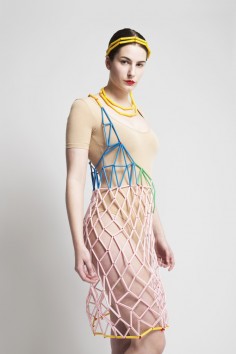Ola Mirecka
Fashion Clash

source: olamireckapl
Ola Mirecka grew up in Warsaw, Poland. She studied Design at the Academy of Fine Arts in Warsaw where she was a member of the PG13 platform (led by Tomek Rygalik) – responding to experimental design briefs, exhibiting, organizing and taking part in design workshops and competitions as well as industry supported projects.
Ola participated in a two-year artist in residence called: Rooted Design for Routed Living. Alternative Design Strategies. This programme was based on exchanges between Polish and Norwegian designers and artists.
After completing her studies in Poland she moved to London to study at the Royal College of Art. Ola took her masters degree in Design Products under Daniel Charny and Roberto Feo graduating in 2012.
Ola’s work often explores the idea of drawing, through three-dimensional language, narrative, performance, and moving image.
Her work has been awarded and exhibited internationally, as well as featured in numerous publications.
She is currently working as a designer at Lego in Denmark.
.
.
.
.
.
.
.
source: culturepl
Not only does she design objects, but she arranges whole situations of sort, creating a phantasmagoric world distinguished by its almost childlike sensibilities. It’s a world full of colour and surprising lines, childhood illustrations brought into real, three-dimensional space.
Mirecka (born 1986) graduated from the Faculty of Industrial Design of the Academy of Fine Arts in Warsaw. She was taught by Tomek Rygalik in his PG13 experimental course, where she soon found where her talents lay. She was also involved in a two-year Polish-Norwegian exchange programme centred around the issue of alternative methods of design. After graduating in Poland, she continued her studies at the Royal College of Art in London in the studio of Daniel Charny and Robert Feo.
In her works, Mirecka is often inspired by folk tradition, drawing from traditional forms, such as for the wooden spinning tops she designed for the Ethnographic Museum, or she takes inspiration from traditional materials and turns them into modern items like with the Rusałka (Rusalka) swing made out of braided wicker.
However, it is not the folk influences that are the key to understanding Mirecka’s work. Most of her projects are addressed at the youngest users. She creates for children, somehow herself remaining a child with an open mind, a sense of exploration and an uninhibited imagination. Her toys allow one to fly, jump and climb, stimulating the user to constantly move and seek adventure. Węże/ makarony (Snakes/Pasta) is a custom-made compact playground with a colourful dust cover designed to be used indoors. Guziko-pętelki (Button-Loops) can be combined into any shape, and used as forts, houses, or simply as a comfortable place to sleep.
LAVA is a portable lemonade stand that encourages human interaction. Its construction, based on winding lines, evokes a dreamlike environment. Mirecka invites one to try some lemonade made with freshly squeezed fruit. A suitable bend in the table allows one to fit in a small cup as well as larger jugs. Red metal rods outline the shape of the bar, table, benches and ladders, creating an ’uncontrolled experiment‘ in the designers’ own words. [thisispaper.com].
In Stonki, Mirecka again returns to the concept of a three dimensional illustration, as in LAVA. These sketch-like spatial formations may take the form of a lamp, stool or even a clock. The frame of the object is made of aluminium tubes connected by plastic connectors. The artists’ handprint is imprinted onto the elements of various shapes and colours, adding a contrasting detail to the whole structure. These spontaneous, uncontrolled creations highlight the lightness of their forms, perhaps best showcasing what Mirecka is all about: a child’s imagination combined with the mind of an organized designer.
.
.
.
.
.
.
.
source: tlmagazine
Exploring design through interaction, Ola Mirecka’s work closes the gab between creator and user. “Exhibitions often present design like art but rarely reveal true use,” she explains. Tapping into a diverse range of experiences – studies at the Academy of Fine Arts, Warsaw Design Faculty – as part of Tomek Rygalik’s PG13 programme – the Royal College of Art, High School improv groups, illustration traineeships at Warsaw-based advertising agencies and a current position at Lego in Denmark – the product designer has developed a methodology all her own. “I play with shape in real 3D space, putting objects together to find new forms,” Mirecka describes. “I try to create something I’ve never seen before.” The young product designer’s approach isn’t limited to live composition but is also rooted in the need to help others and experiment
with material. “Every medium allows you to play with it, once you get a certain know-how and flexibility, employing the right machines,” she confesses. Though currently tasked with Lego girl-oriented products. Mirecka continues to develop S-t-o-n-k-i – 3D illustrations drawn in space using solid material. Aluminum tubes are quickly and instantaneously connected with biodegradable thermoplastic joints. The technique has resulted in pendant lamps, stools, standing clocks and now, a shoe rack. “Sketching in space and then on paper, I add action to thinking,” she explains. This young talent brings play back into daily life.

